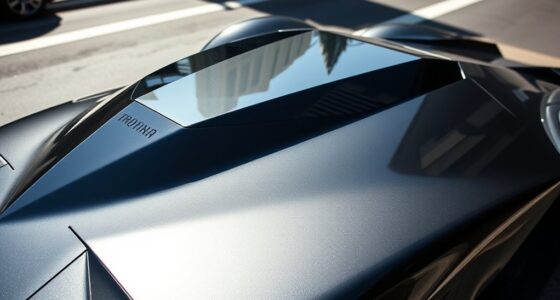If you’re choosing between disc and rim brakes, consider your riding needs. Disc brakes offer consistent stopping power in all weather and dirt conditions, making them great for challenging terrain or wet days. Rim brakes are lighter, simpler, and easier to maintain, ideal for paved roads and casual riding. Both systems have pros and cons, so understanding how each performs can help you pick the best option—there’s more to uncover if you keep exploring.
Key Takeaways
- Rim brakes are lighter and simpler, ideal for weight-conscious riders and easy maintenance.
- Disc brakes provide consistent stopping power in all weather and challenging conditions.
- Rim brakes are more vulnerable to dirt and water, reducing performance in muddy or wet environments.
- Disc brakes involve more components, making them heavier and requiring more complex installation and upkeep.
- The choice depends on riding conditions, terrain, maintenance willingness, and preference for weight savings or reliable braking.

When choosing bicycle brakes, understanding the differences between disc and rim brakes can considerably impact your riding experience. Both systems have their strengths and weaknesses, but knowing how they influence aspects like brake maintenance and weight considerations will help you make an informed decision. Rim brakes are simpler and lighter, making them a popular choice for road cyclists and casual riders. They rely on brake pads pressing against the wheel’s rim, which means fewer components to worry about and easier maintenance. You can quickly adjust or replace brake pads, and since there are fewer moving parts, the upkeep tends to be straightforward. However, rim brakes are more sensitive to dirt, mud, and water, which can reduce braking performance and increase the frequency of brake maintenance. If you regularly ride in adverse weather or muddy conditions, you’ll need to clean your rims more often, and brake pads may wear out faster.
Rim brakes are lightweight, simple, and easy to maintain but sensitive to dirt and water.
In contrast, disc brakes are generally more durable and reliable, especially in challenging conditions. They use a rotor attached to the hub and calipers that clamp down when you pull the brake lever. This setup provides consistent stopping power regardless of weather or dirt, reducing the need for frequent brake maintenance. But, disc brakes tend to be heavier because of the additional components—rotors, calipers, and mounting hardware—adding weight to your bike. This extra weight can influence your riding, especially if you’re racing or covering long distances where every gram counts. Disc brakes also require more complex installation and occasional bleeding to maintain ideal performance, so you’ll need to be comfortable with more involved brake maintenance routines. Additionally, advancements in brake technology continue to improve performance and ease of maintenance for both systems.
Weight considerations extend beyond just the brake system itself. Because disc brakes add weight to your bike, you might feel a difference in handling, especially if your bike is already on the heavier side. Rim brakes, being lighter, can help keep your total bike weight down, making climbs easier and acceleration quicker. On the other hand, the enhanced stopping power and consistency of disc brakes can justify their added weight if you prioritize safety and performance in diverse riding environments.
Ultimately, your choice depends on your riding style, terrain, and maintenance preferences. If you prefer a lightweight setup with simple maintenance and mostly ride on paved roads, rim brakes might suit you best. But if you need reliable stopping power in mixed conditions and don’t mind a bit more weight and maintenance, disc brakes are a solid option. Consider how much weight you’re willing to carry and how often you’re comfortable performing brake maintenance, as these factors will profoundly impact your overall riding experience.
Frequently Asked Questions
How Do Disc Brakes Perform in Cold or Wet Conditions?
Disc brakes perform better in cold or wet conditions because of their excellent weather resilience. They maintain consistent stopping power, even when mud or water gets on the rotors. Unlike rim brakes, which can struggle with mud performance and reduced grip, disc brakes stay reliable, ensuring you can stop safely regardless of weather. Their design helps keep performance steady, making them a great choice for challenging riding conditions.
What Maintenance Is Required for Disc Versus Rim Brakes?
You need to regularly check your disc brakes for caliper adjustment to guarantee proper alignment and braking power. If your rotor wobbles, rotor truing becomes necessary to maintain smooth operation. Rim brakes mainly require pad replacement and rim cleaning, whereas disc brakes demand occasional caliper adjustments and rotor truing to prevent squealing and uneven wear. Staying on top of these maintenance tasks keeps both systems performing at their best.
Are Disc Brakes Compatible With All Bike Frames?
Disc brakes are not compatible with all bike frames because of differing frame compatibility and brake mounting standards. You need to check if your frame has the appropriate mounts for disc calipers and the correct spacing for rotor size. Some older frames may lack the necessary mounts or clearance, so confirm your bike’s frame supports disc brake installation. Always verify compatibility before upgrading to disc brakes to avoid fitting issues.
How Does Brake Pad Replacement Differ Between Disc and Rim Brakes?
When replacing brake pads, disc and rim brakes differ like switching between a precision instrument and a simple tool. With disc brakes, you check caliper alignment and replace pads, paying attention to pad wear indicators for even wear. Rim brakes involve removing the wheel, inspecting the pads, and ensuring the brake arm is properly aligned. Both require attention to detail, but disc brakes demand more careful caliper alignment for peak performance.
What Are the Cost Differences Over the Bike’s Lifespan?
You’ll find that disc brakes generally have a higher initial cost but offer better lifespan durability, reducing long-term expenses. Rim brakes are cheaper upfront and easier to maintain, but their parts tend to wear out faster, leading to more frequent replacements. Over the bike’s lifespan, the cost comparison favors disc brakes if you value durability and consistent performance, though your riding style and maintenance habits also influence total expenses.
Conclusion
Choosing between disc and rim brakes depends on your riding style and conditions. Did you know that disc brakes provide 20% more stopping power in wet conditions? That’s a game-changer if you often ride in rain or muddy trails. Ultimately, weigh the benefits and your riding needs. Whether you prefer the consistent performance of disc brakes or the lightweight simplicity of rim brakes, making an informed choice keeps you safe and confident on every ride.









